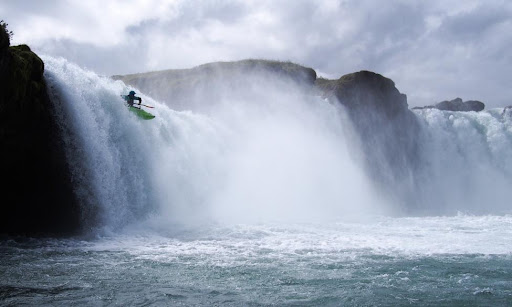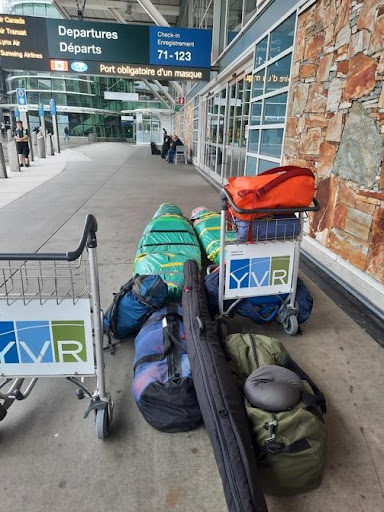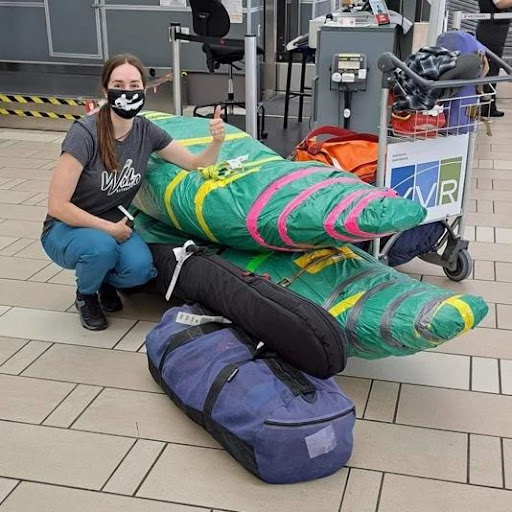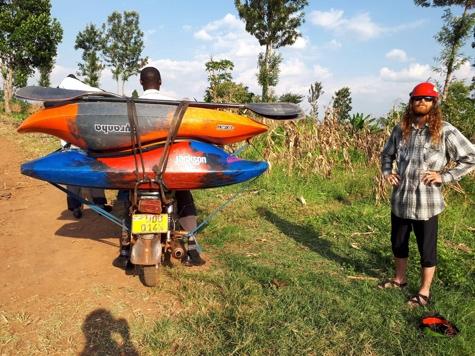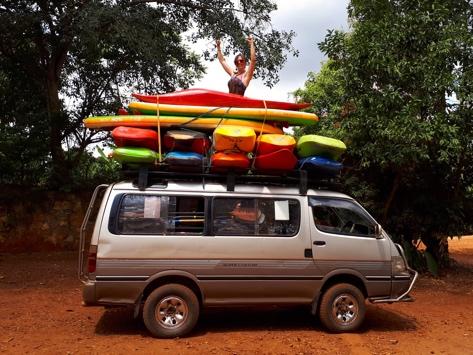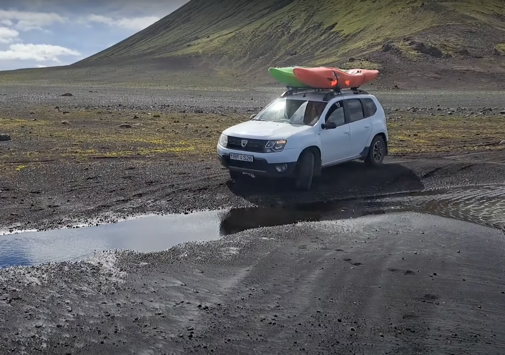I used to watch kayaking videos of the pros paddling in international destinations and thought that was the epitome of the sport. Flying with a whitewater kayak was reserved for the elite and would never be something that a mere mortal like myself could possibly attain. I was perfectly content to paddle the rivers in my backyard, and put the dreams aside of kayaking in warm tropical waters. After all, road trips can also take me to some incredible places, and I don’t mind the cold water in a good drysuit and pogies.
A month after I first met my husband, he took off on a four month kayaking trip to Africa. I thought it was awesome, but he was a significantly better kayaker than I was, and so it still seemed out of range for myself. A couple of years later, we began planning a trip to Uganda together – with both of our kayaks. Was I dreaming? Had I become one of the “elite”? Far from it, but I was stoked to be planning this new sort of adventure. It opened my eyes that anyone can fly with a kayak, regardless of skill level.
I have now flown internationally with both playboats and creekboats, with one trip to the White Nile and another trip to Iceland. There are many more destinations that I now dream of someday getting the chance to paddle and explore – Zambezi, Chile, Nepal, Mexico, Ecuador, New Zealand… the list goes on. If you’re thinking of planning an international whitewater paddling trip, here’s a few tips that might help you along the way!
Booking your flight
The two major airlines in Canada, Air Canada and WestJet both accept Whitewater Kayaks as “sporting equipment”. WestJet has done it for a while now, and ever since Air Canada deemed themselves the official airline of Canadian Olympics teams, where whitewater slalom is a recognized sport, they’ve also begun to accept kayaks. Gone are the days when you had to pretend that your whitewater kayak was a “wave ski” or a “surf board” in order to get it onto the plane. Kayaks are officially good to go!
Both airlines have similar policies on carrying kayaks, and specific details can be found on their websites (2022). For Air Canada, check out the link – https://www.aircanada.com/ca/en/aco/home/plan/baggage/special-items.html#/, and look for the “Kayaking Equipment” tab. For WestJet, check out the link – https://www.westjet.com/en-ca/baggage/sports, and look for the “Kayaks” tab.
When making your flight booking, you will need to indicate your “special equipment” baggage. You will need to call the airline once you’ve booked your flight, and let them know that you plan to bring a whitewater kayak and register it for your flight. The planes also have to be a certain size in order to accept the bulky gear – not every plane will accept boats.
If you have connecting flights in your planned itinerary, it’s a good idea to give any other airlines that may be included in your trip a call to check their policies on carrying kayaks and make sure they have space. Not all airlines will allow them, so you may have to pick and choose who your connecting flights are with. There is a limit to how many kayaks airlines can accept, so make sure to enquire about this when calling the airline as well. They are often only accepted “if space allows” but they may also have a limit of 2 or 3 whitewater boats per flight.
Good news: your kayaking equipment all together will typically count as “one piece of baggage”. This means that you can have your kayak, paddles, and gear bag (3 bags) count as only one piece of sporting equipment. However make sure not to pack other non-kayaking related gear in these bags, or it will count as additional baggage.
There is a size and weight limit for the kayaks, so it’s a good idea to get this checked out ahead of time. Sea kayaks are too big, but most creek boats should fit within the maximum dimensions. For both Air Canada and WestJet, these dimensions are:
- Maximum length: 300cm (9ft 8in)
- Maximum width: 76cm (18in)
- Maximum height: 45cm (30in)
Note that Air Canada says the width must be 45cm, and the height 76cm, so you just need to measure the boat on its side! WestJet has it straight.
- Air Canada Maximum weight: 23kg (50lbs) – extra fee if it is overweight, up to 32kg (70lbs)
- WestJet Maximum weight: 23kg (50lbs)
Another thing to consider is whether you plan to return with your kayak or sell it over there. Often the places we choose to visit may have a difficult time importing kayaks, and they may really appreciate having your boat over there when you return home. If you plan to return with your kayak, make sure to check there is space on the return flights as well.
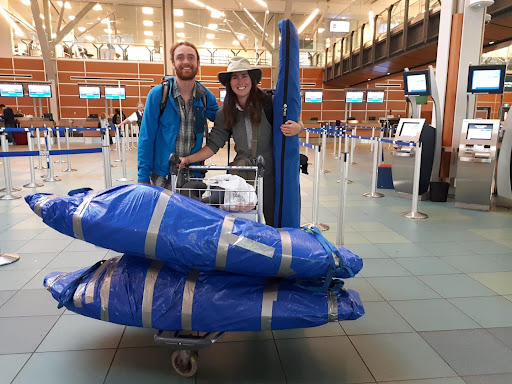
Garrett Quinn and Heather Buckingham with their playboats at the Vancouver Airport about to fly to Uganda to paddle the White Nile. Photo by Bill Buckingham.
Packing your equipment
You’ve called the airline. They’ve registered your kayak. You’ve called to double check closer to the date, and it’s still good to go. You’re starting to pack your suitcase… but how do you pack your kayak and gear?
I recommend having a bathroom scale on hand to weigh your gear. Most kayaks when empty will weigh in under the 50lb weight limit, so you may want to pack some lightweight things in there to make the most out of that space. PFDs and skirts are good things to stuff in, and any other paddling gear so long as you keep it under the weight limit.
The airline websites will tell you that your kayak needs to be packed in a “rigid or hard shell container specifically designed for shipping”. Little do they know that most of our kayaks are made of plastic – which is already a rigid and hard shell designed for shipping. If you’re travelling with a plastic kayak, you don’t need to go out and buy a fancy case for it. Our budget-friendly solution requires only 3 things: a tarp, duct tape, and some webbing. Buy a tarp that is big enough to completely wrap your kayak in. Secure it in place with duct tape, and write your name in sharpie all over it. Voilà! You have packaged your kayak.
Now how do you carry it? With it all wrapped up, you can no longer carry it over your shoulder like you used to. Our solution: get a pair of scissors to cut some holes through the tarp/duct tape burrito wrap specifically at the grab handles – one on the bow and another on the stern. Thread the webbing through the grab handles, and figure out the best configuration that will work for you to hold and carry the boat over short distances. Hopefully you won’t need to carry it very far in this condition!
Paddles however present a slightly more challenging situation. They are not as good an item to ship “as is”. I recommend buying or borrowing a paddle bag to carry these. Other solutions could also include only bringing over a breakdown paddle, and storing it in your kayak. If you’re using a paddle bag, it’s also a good idea to store extra paddling gear in there – wrap it around the paddle to help protect it a bit too. The paddle bag is a good place to store a spray skirt, pogies, paddling layers – neoprene tops or bottoms, or even a drysuit, carefully folded.
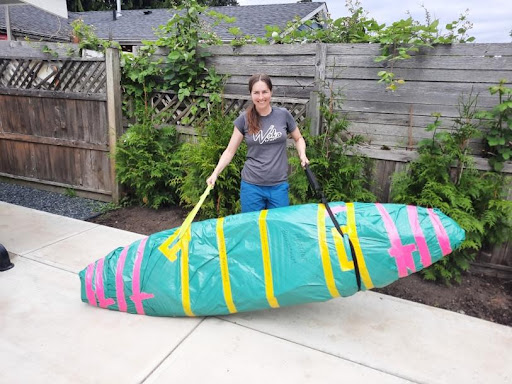
Getting to the airport
Your kayak is burrito’d and full of gear (but still amazingly under 50lbs!). You’ve loaded it onto a car and got your buddy to drop you off at the airport. You wave goodbye, and are standing next to a pile of gear: your kayak burrito, your paddle bag, your kayak gear bag, your suitcase, and your carry-on. How do you get all of this stuff inside and onto the plane?
You will need to find a cart. Creekboats will fit sideways on a cart, but they typically won’t fit their ~9ft width through a doorway easily. This part requires some improvisation. Airports recommend that you arrive an additional 30 minutes early if you are bringing a kayak – and for good reason. 1) They’re difficult to maneuver through the crowds and the lineups cues. 2) Airport staff rarely have experience dealing with kayaks, and don’t always know what to do, even though you’ve done all your homework ahead of time. Have some patience, and make sure you have all your paperwork and passport ready so everything else goes seamlessly.
You will likely have to go through the in-person airline kiosk as opposed to the self check-in as kayaks are not typically an option on their drop-down menus for checked bags. The kayaks and paddles will be checked through in the oversize and oddly shaped special baggage drop. Airline staff may have you drop all your checked bags there together, or they may take your regular sized suitcase at the kiosk desk. Their call. Once your kayak goes on the conveyor belt and through the black curtains, cross your fingers and hope it will show up at your destination!
Destination preparation
You’ve planned your dream kayaking trip to… the Nile, Iceland, Mexico… wherever it may be, you’ve done your research and have some sort of a plan in mind, or maybe you’re wondering how to start making that plan?
Once you have a destination in mind, it’s a good idea to seek some local knowledge and beta about the rivers you hope to paddle. Many world-class destinations may have guided trips that will do all this work for you for a fee. Others don’t yet have this established. If you’re on more of a budget and looking to paddle with some friends, or meet some along the way, a good place to begin is often with local rafting companies. Find out who operates on the river and see if you can join them for a day. You will often find kayakers at rafting companies who would love to paddle with you on their time off, or let you join alongside on a trip. See if there are any local clubs or groups that have events or paddling days posted online. Sign up for a guided run down the river. Check out local guidebooks, online beta, google maps, YouTube videos, etc.
So you’ve got a plan. You arrive at your destination, and all your gear comes through at the same time – congratulations! Find a cart to maneuver your way out of the airport. Next question, hopefully already considered – how do you get from the airport to where you are going – will you be renting a vehicle or not?
The answer may be different depending on where you go. If you plan to get picked up by a taxi from the airport, note that most don’t have roof racks. Most playboats may fit inside taxi-vans, but creekboats will not. In many African countries, this problem can be solved by putting a sheet of cardboard on the roof, and strapping the boats down through the windows of the car. This might not be an option everywhere you travel… Find out if there is a rafting or kayaking base that can help connect you with an airport shuttle. If you plan on renting a car, make sure that it has GOOD roof racks installed. Not every car rental company will have cars with roof racks. You may have to brainstorm how to get around this. I saw on youtube some bros who have even flown with two-by-fours in their paddle bags to make impromptu roof racks. Consider if you are travelling alone or with a crew, and how easy would it be logistically to achieve your goals with or without a car?
When we flew to Uganda, we arranged to have 3 days of guided kayaking with Kayak the Nile before exploring on our own. They arranged our transport from the airport, and on this trip we opted not to rent a car. It was easy enough to get around on the river by paying local drivers on boda-bodas, cars, or vans (depending on the number of people we would paddle with) to help us with our shuttles. In Iceland, we opted to rent a car with roof racks to travel much greater distances. There was also a much smaller kayaking scene, so we were mostly reliant on each other, putting on running shoes to run our shuttles, and using online beta to get around the country.
Is it worth it?
Travelling internationally is a gift and has a climate cost. If you have the privilege to be able to do it, I highly recommend giving it a try. Exploring other countries and cultures offers so many different perspectives, a greater understanding of our world and the people in it. And paddling new styles and sections of whitewater can be an awesome way to develop your boating skills.
One of the things I love the most about travelling and meeting other kayakers abroad is coming to the realization that we are all part of an amazing community. I almost always meet someone who knows someone who I know. We are a small group of eccentric people, but have this incredible passion that draws us all together in some of the most wonderful, beautiful, and amazing places on earth. It feels like I have a family, no matter where in the world I travel.

